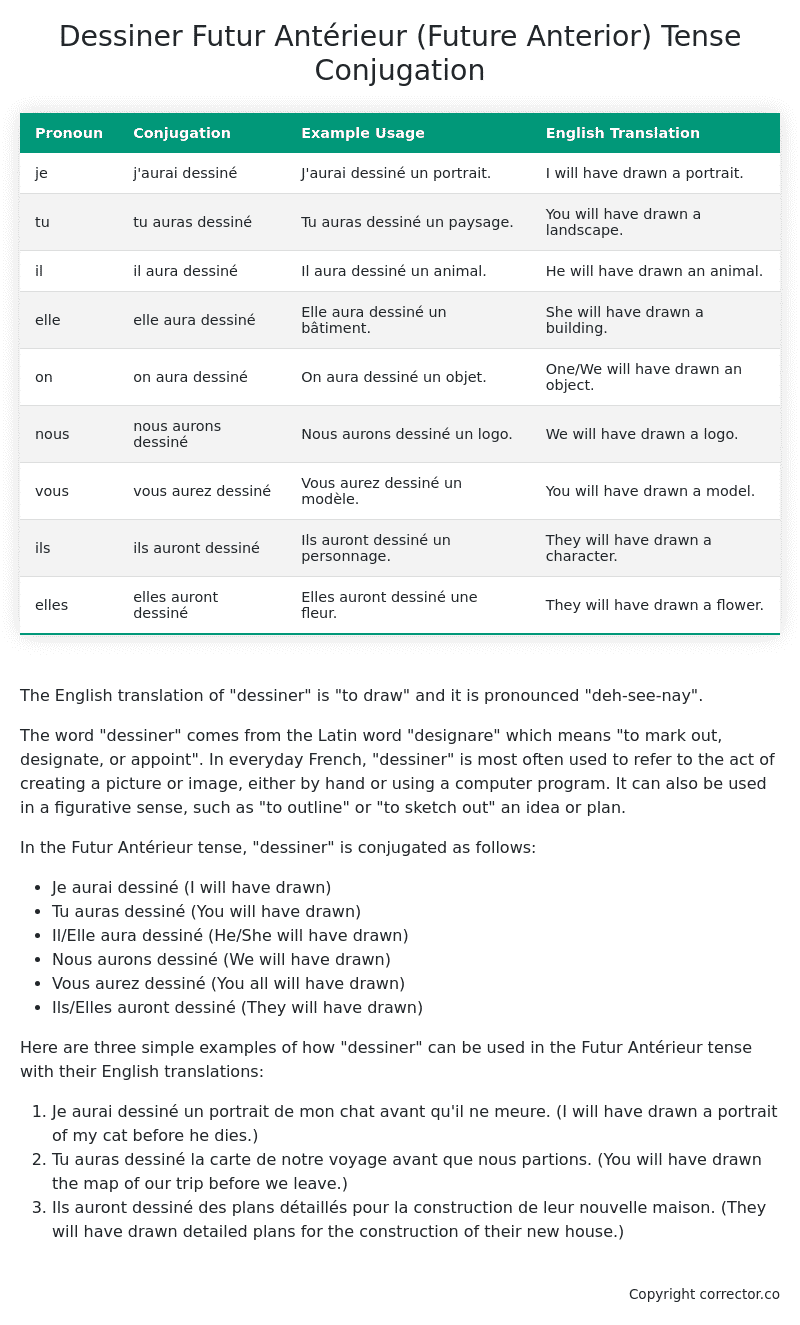Futur Antérieur (Future Anterior) Tense Conjugation of the French Verb dessiner
Introduction to the verb dessiner
The English translation of “dessiner” is “to draw” and it is pronounced “deh-see-nay”.
The word “dessiner” comes from the Latin word “designare” which means “to mark out, designate, or appoint”. In everyday French, “dessiner” is most often used to refer to the act of creating a picture or image, either by hand or using a computer program. It can also be used in a figurative sense, such as “to outline” or “to sketch out” an idea or plan.
In the Futur Antérieur tense, “dessiner” is conjugated as follows:
- Je aurai dessiné (I will have drawn)
- Tu auras dessiné (You will have drawn)
- Il/Elle aura dessiné (He/She will have drawn)
- Nous aurons dessiné (We will have drawn)
- Vous aurez dessiné (You all will have drawn)
- Ils/Elles auront dessiné (They will have drawn)
Here are three simple examples of how “dessiner” can be used in the Futur Antérieur tense with their English translations:
- Je aurai dessiné un portrait de mon chat avant qu’il ne meure. (I will have drawn a portrait of my cat before he dies.)
- Tu auras dessiné la carte de notre voyage avant que nous partions. (You will have drawn the map of our trip before we leave.)
- Ils auront dessiné des plans détaillés pour la construction de leur nouvelle maison. (They will have drawn detailed plans for the construction of their new house.)
Table of the Futur Antérieur (Future Anterior) Tense Conjugation of dessiner
| Pronoun | Conjugation | Example Usage | English Translation |
|---|---|---|---|
| je | j’aurai dessiné | J’aurai dessiné un portrait. | I will have drawn a portrait. |
| tu | tu auras dessiné | Tu auras dessiné un paysage. | You will have drawn a landscape. |
| il | il aura dessiné | Il aura dessiné un animal. | He will have drawn an animal. |
| elle | elle aura dessiné | Elle aura dessiné un bâtiment. | She will have drawn a building. |
| on | on aura dessiné | On aura dessiné un objet. | One/We will have drawn an object. |
| nous | nous aurons dessiné | Nous aurons dessiné un logo. | We will have drawn a logo. |
| vous | vous aurez dessiné | Vous aurez dessiné un modèle. | You will have drawn a model. |
| ils | ils auront dessiné | Ils auront dessiné un personnage. | They will have drawn a character. |
| elles | elles auront dessiné | Elles auront dessiné une fleur. | They will have drawn a flower. |
Other Conjugations for Dessiner.
Le Present (Present Tense) Conjugation of the French Verb dessiner
Imparfait (Imperfect) Tense Conjugation of the French Verb dessiner
Passé Simple (Simple Past) Tense Conjugation of the French Verb dessiner
Passé Composé (Present Perfect) Tense Conjugation of the French Verb dessiner
Futur Simple (Simple Future) Tense Conjugation of the French Verb dessiner
Futur Proche (Near Future) Tense Conjugation of the French Verb dessiner
Plus-que-parfait (Pluperfect) Tense Conjugation of the French Verb dessiner
Passé Antérieur (Past Anterior) Tense Conjugation of the French Verb dessiner
Futur Antérieur (Future Anterior) Tense Conjugation of the French Verb dessiner (this article)
Subjonctif Présent (Subjunctive Present) Tense Conjugation of the French Verb dessiner
Subjonctif Passé (Subjunctive Past) Tense Conjugation of the French Verb dessiner
Subjonctif Imparfait (Subjunctive Imperfect) Tense Conjugation of the French Verb dessiner
Subjonctif Plus-que-parfait (Subjunctive Pluperfect) Tense Conjugation of the French Verb dessiner
Conditionnel Présent (Conditional Present) Tense Conjugation of the French Verb dessiner
Conditionnel Passé (Conditional Past) Tense Conjugation of the French Verb dessiner
L’impératif Présent (Imperative Present) Tense Conjugation of the French Verb dessiner
L’infinitif Présent (Infinitive Present) Tense Conjugation of the French Verb dessiner
Struggling with French verbs or the language in general? Why not use our free French Grammar Checker – no registration required!
Get a FREE Download Study Sheet of this Conjugation 🔥
Simply right click the image below, click “save image” and get your free reference for the dessiner Futur Antérieur tense conjugation!

Dessiner – About the French Futur Antérieur (Future Anterior) Tense
Construction
Common Everyday Usage Patterns
Interactions with Other Tenses
For example
Summary
I hope you enjoyed this article on the verb dessiner. Still in a learning mood? Check out another TOTALLY random French verb conjugation!


